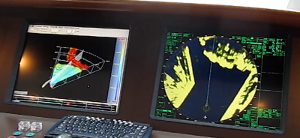The 3D FLS Operator Experience: Making a Good Sonar Great
Our operator interface installed on a bridge next to a radar.
FarSounder's engineers spend a lot of their time working with customers to understand their navigation sonar needs. We strive to design our 3D FLS products with a good balance of performance metrics. However, our systems are more than just hardware. The software display is an important component too and as the saying goes, "a picture is worth a thousand words". That's why we've invested heavily in our operator interface, making a system that is easy to operate and easy to understand. Let's take a closer look at some of these features.
Single Ping 3D Imaging
FarSounder's products are true 3D sonars. This means that they create a complete 3D image (range, bearing and depth) with a single ping. This enables our software to update the entire navigational scene with a single ping.
"3D sonar" is a term that should be clear but isn't always. Some sonars which bill themselves as 3D are actually only 2D sonars which build a 3D image with multiple pings. These other sonars may make pretty pictures but are not generally suitable for navigation applications as the 3D image which is built is what the vessel has already passed over, not what is ahead.
Image Stabilization
The sea is a dynamic environment impacting even the largest yachts, cruise ships, and service vessels. Waves create roll and pitch motion as well as transient reflections and bubble clouds. Our software has two features designed to stabilize the navigation situational awareness onboard the ship.
Roll & Pitch
Even with stabilizers, waves can induce pitch and roll. As the vessel rolls and pitches, the sonar sensor is changing its angular orientation relative to the sea floor. Since people generally orient themselves to a fixed frame of reference, it is necessary to correct the orientation of the sonar's output for the roll and pitch of the vessel. Otherwise, our display of the sea floor would be constantly changing orientation as the vessel moves over the waves. FarSounder's sonars have a roll and pitch sensor integrated inside the Transducer Module. The changing orientation of the sonar is measured with each ping allowing the software to stabilize the image shown to the operator.
Ping to Ping
FarSounder's sonars can create a three dimensional images at navigationally significant ranges with a single ping. Since the sonar's field-of-view is large, there is a large overlapping footprint from ping to ping. The sonar signal processing algorithms inside our software look at these overlapping regions and filter out transient reflections. The software actually tracks every target it detects and only displays it to the user if it is seen more than once. This is similar to the persistence feature on a radar. More details about our target stabilization feature can be found in a previous blog posting.
Chart Overlay
Chart overlay is another valuable feature which aids operator comprehension of a navigation sonar. A chart overlay is produced by correlating the sonar's data to a geo-spatial position and displaying information from the sonar data on top of a digital chart. Though this capability is not a performance metric of the sonar hardware, it is a valuable metric of the sonar system. Such a capability requires ship position and heading information input to the processing and display software. Generally, this can be achieved via external NMEA compatible gps and heading sensors. Chart overlay is included in FarSounder products.
The Future of Operator Interfaces
Our development team is always working to make our software better. We encourage feedback from our customers, and many of our customers' feature requests are included with new releases. As we release new features, eligible customers are able to upgrade their sonars through simple software updates.




